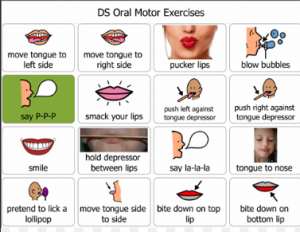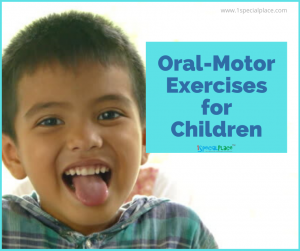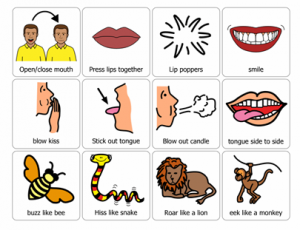
Oral Motor Exercises for Children
Oral Motor Exercises for Children
Skills refer to the appropriate functioning and use of the facial muscles (lips, jaw, tongue, cheeks, and palate) for speaking and eating. Achieving oral-motor skills is an important part of every child’s communication and feeding development. Normal oral motor development begins during foetal stage and continues up until 4 years of age. By 3 years of age a child should be able to consume liquids and solids through straws and open mouth cups and chew advance food textures such as whole fruits, meats etc.
It’s critical to understand the rationale behind the exercises we evaluate while discussing oral motor exercises. Through oral motor activities, we hope to help the kid show the coordination required for sound generation and articulation by improving the way their mouth, jaw, lips, cheeks, and tongue function. Other manipulation-related problems include chewing, moving foods and liquids, tolerating different textures, and swallowing food and liquids.
Read here to learn about Childhood Apraxia of Speech.
Oral Motor Exercises for Children
Delay or deviant oral-motor development may lead to poor verbal communication skills and feeding difficulties. Some children diagnosed with Autism Spectrum Disorder (ASD), Attention Deficit Hyperactivity Disorder (ADHD), Down’s syndrome, Intellectual Disability and Global Developmental Delays present with weakness of oral muscles. Oro motor exercises help to improve strength, range of movement and co-ordination of the oral muscles which will facilitate better speech and swallowing function.
What are oral motor skills?
Oral motor skills are the motions of muscles in the jaw, tongue, mouth, and lips. The tone, strength, and motion coordination of your baby’s facial muscles allow him or her to move the oral structures necessary for suckling, chewing, biting, facial emotions, and communication. Oral motor abilities develop smoothly in large part because of consistent practice and maturation of the oral cavity’s muscles. On the other hand, some kids might not acquire their oral motor skills as quickly. Speech-language pathologists and occupational therapists can address current issues and promote healthy oral motor development.
The following lists the skills for the functioning of all facial muscles:
- Awareness
- Strength
- Co-ordination
- Movement
- Endurance
Who needs oral-motor exercises?
These are some red flags in a child that oral-motor skills need attention:
- Speech sound errors/ delayed verbal language skills
- Mouth is usually in open position
- Tongue hangs out of the mouth
- Drooling/ Excessive saliva secretion
- Often food falls out of the mouth while feeding
- Difficulty chewing and biting
- Unable to elevate or protrude tongue
- Choking or coughing often while eating
- Gagging while feeding
- Unable to suck, lick, chew or blow
- Preference of specific food texture/ oral sensory issues
“If any of the above stated issues have been persisting in a child, it is highly recommended to first consult with a Speech-Language Therapist.” Contact us now.
How and when should you practice with your child?
The activities listed below are easy to practice with children. Try to incorporate the exercises during play time with your child. It is very important to demonstrate and model these exercises to facilitate faster learning. You can use a mirror or a puppet to make it interesting. If a child is unable to do a particular oral-motor exercise listed below, it’s an indication to train for that specific muscle group. These exercises can be repeated three to six times a day until the skills improve. Every child learns at his/her own pace, progress may be noted in a few days to weeks or sometimes it may also take months.
“If you are already consulting with a Speech-Language Therapist, please follow their advice regarding your child.”
Oral motor exercises:
Lip exercises:
- Make a smile (hold for 3 seconds), relax and repeat the same

- Make a smile then say “ooooo” , “eeeeeee”
- Lip pops, say “pop” “puh” “pe” with exaggerated pressure
- Lollypop squeeze (Hold and squeeze lollypop with lips for 6 seconds)
- Lip press (press your lips together for 3-6 seconds)
- Make a kiss (hold 3-6 seconds)
- Smack lips together (5 times)
- Make humming sounds
- Drink through a twisty straw
Read here about Oral Placement Therapy Tools
Cheek exercises:
- Make silly faces in a mirror
- Blow bubbles or puff balls
- Blow cheeks with air and hold (3-6 seconds)
- Massage cheeks with two fingers in clockwise and anti-clockwise direction (6 times)
- Holding ice cream stick between lips (3-6 seconds)
- Drink from a straw
Jaw exercises:
- Chewing a candy
- Chewing a chewy stick or toy
- Drinking thick milkshake from a straw
- Playing tug-a-war by holding a chewy candy in between the lips and you pull it away
- Open the jaw wide and say “aaah” (hold 3-6 seconds)
- Massage the jaw gently towards and away from the lips
- Chew to make a paste of advance food textures (carrots, apples, pear etc)
- Ice chips on jaw and lips to improve sensory awareness
Tongue exercises:
- Lick lollipops up and down protruding the tongue outside the mouth
- Licking honey or yogurt from sides of the lips
- Tongue clicks and popping sounds
- Hold tongue elevated (3-6 seconds)
- Hold tongue outside the mouth (3-6 seconds)
- Touch tongue tip to nose
- Push and hold the tongue inside both sides of cheek (3-6 seconds)
- Chew a biscuit to make it soft and mushy
- Fold and hold tongue tip between lips (3-6 seconds)
- Push against a lollypop on either side protruding the tongue (hold 6 seconds)
- Gently press the lollypop on the tongue (6 times)
- Place chocos or cheerios on the tongue tip and lift and press against the palate
- Say “puh tuh kuh” repeatedly in the order
- Say “lalalala” “tatata”
- Say “shhhhh”
- Say “Brrrrrrrr”
Read here to learn more about tongue aerobics.
Palate exercises:
- Puff cheeks and breath through nose while someone presses on against the cheeks
- Straw blowing
- Transfer puff balls through a straw from one bowl to another
- Blow cotton balls or bubbles in water
- Say “aahhhh”
- Say “ma ba” alternating
- Say “na da” alternating
- Eat cold food (ice cream etc) for oral awareness
Click here to see a detail video on oral motor skills
Important advantages of oral motor exercises:
Oromotor exercises are essential for the development of speech and language and have several advantages for those with speech and language problems, challenges, or neurological impairments affecting the orofacial muscles. The following are some main advantages:
1. Strengthening and Coordinating Muscles:
Oral motor exercises improve the coordination and strength of the lips, tongue, jaw, and cheek muscles that are used to produce speech. More accurate speech movements and clearer articulation are the results of stronger muscles.
2. Enhancement of Speech:
Speech production muscles that are targeted can help with articulation, pronunciation, and general clarity of speech. People may notice improvements in their communication’s expressiveness and fluency.
3. Encouraging the Ability to Swallow and Feed:
It helps strengthen the swallowing muscles, which is beneficial for people who have dysphagia or difficulty swallowing. Overall swallowing and feeding abilities are improved via increased coordination during the swallowing process.
4. Fostering Awareness of Oral Sensations:
Improved oral sensory awareness is a prerequisite for comprehending and managing mouth muscle movements during speaking and feeding, and oral motor exercises aid in this process. A higher level of awareness helps with feeding and speech output.
5. Children’s Oral Motor Skills:
This activity helps children with speech and language difficulties develop and improve their oral motor skills. The main goals of the exercises are to increase muscle tone overall and lip and tongue movement.
6. Correction of Tongue Thrust:
Tongue thrust is a condition that can cause incorrect tongue posture and dental issues. However, oral motor exercises are an excellent way to manage this issue. The goal of these exercises is to teach the tongue how to properly rest in the mouth.
7. Improving General Communication Abilities:
Better oral motor function leads to enhanced communication abilities. Gaining confidence and fluency through the strengthening of speech production muscles enables people to communicate ideas and thoughts more effectively.
Is oral-motor therapy effective?
Practicing oral-motor exercises will greatly improve a child’s ability to eat better and produce speech sounds with improved clarity. However, not all children may benefit from stand alone oro motor exercises and may need additional Speech-Language therapy. If you are concerned about your child’s speech-language development, please contact a Speech-Language Therapist as soon as possible.
“If you are concerned about your child’s speech-language development, please contact a Speech-Language Therapist as soon as possible.”
With our exclusive Online Speech therapist and best online speech therapy in India, receive cutting-edge treatment from the comfort of your own home. At 1SpecialPlace you have the right to be confident in your communication and to learn from the finest.
Please leave us a comment if you liked the article.
For more ideas check out our other related blogs
View this post on Instagram
- Tele-Speech Remediation of Stuttering: A Case Study - April 22, 2023
- Voice Changes During Puberty in Teenagers - April 11, 2023
- Vital Stim Therapy for Swallowing Difficulty - April 4, 2023







Leave a Comment
(15 Comments)
Excellent presentation and Very clear explanation and informative
Very informative and useful for parents.
Hello, my self Rutu here , i find it very useful, short and simple. thank you so much.
Hello Ms. Rutu, Thank you!
AYESHA ,thanks alot for the information,i really apreciated to found you on line i’m physiotherapist volonteer in a school for children with disability .i really like to be in contact with you.blessings!
Hi Daniel! I’m glad you found this information useful. Thank you for your comment.
Very informative
Thank you 🙏🙏
Thank you!
Can you please say which are isometric and isotonic exercises..from these
My daughter sleeps with an open mouth and has nasal speaking. The ENT recommended to to have the adenoids removed. Thank you for the exercises that you listed. I will be doing them with my daughter and I hope they will improve her condition.
Glad you found them useful! All the best!
My daughter is 9years old and has Autism.
Thank you for reaching out and sharing about your daughter. At 1SpecialPlace, we offer a wide range of therapy services designed to support children with Autism, including speech therapy, occupational therapy, special education, and mental health services. Our team of experienced therapists is here to work closely with your child, providing personalized care to help her reach her full potential.
If you’d like to explore our services or have any specific concerns, feel free to connect with us, and we’d be happy to guide you further. We’re here to support you every step of the way!
+919760226001
info@1specialplace.com
Do you offer printable versions of those exercise photos? They’re too small to copy and print. It would be so helpful to not have to reinvent the wheel! Thank you for this educational post!
Sure we will work on this. Thanks for your suggestion.
Categories
Recent Posts